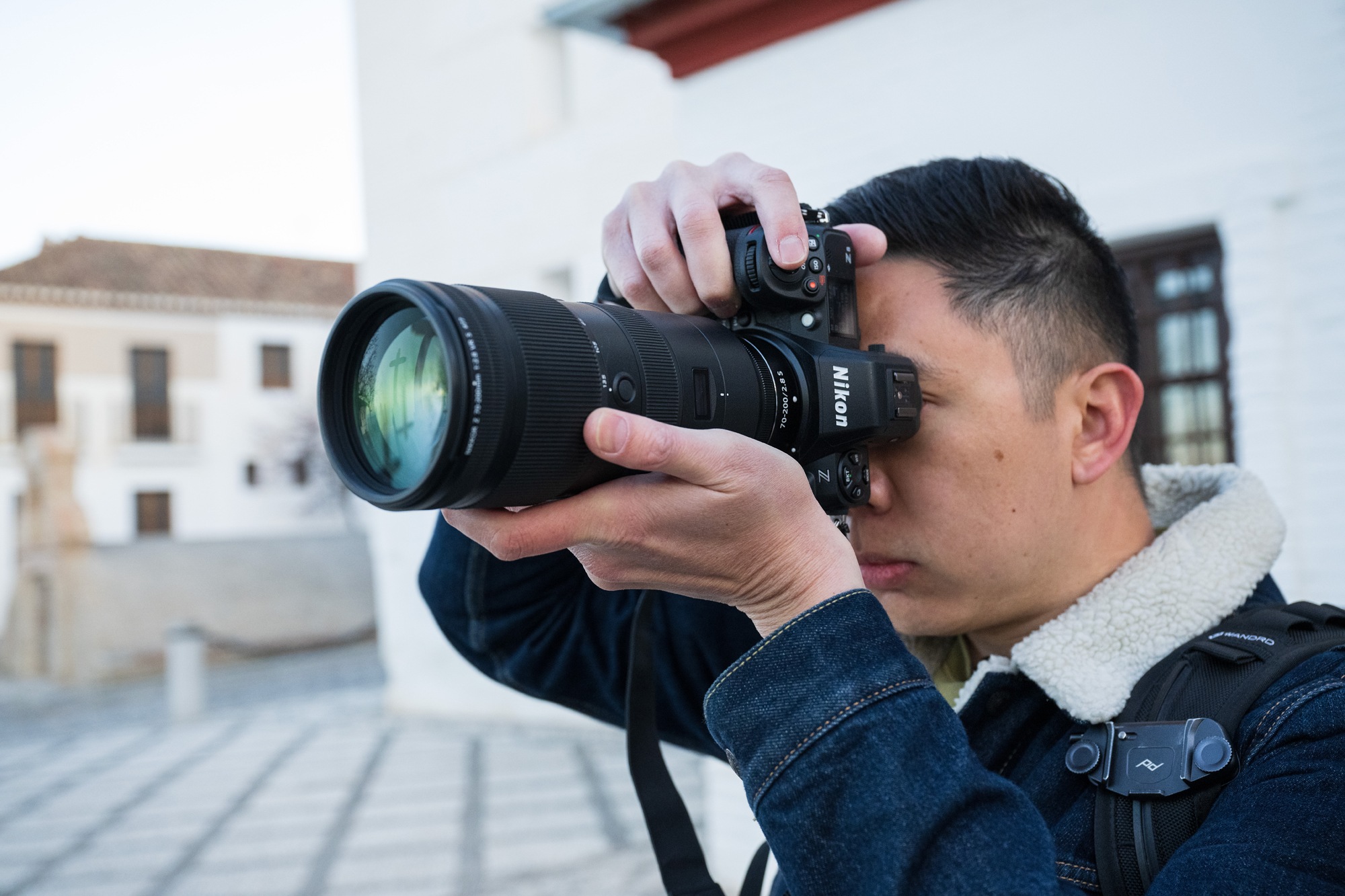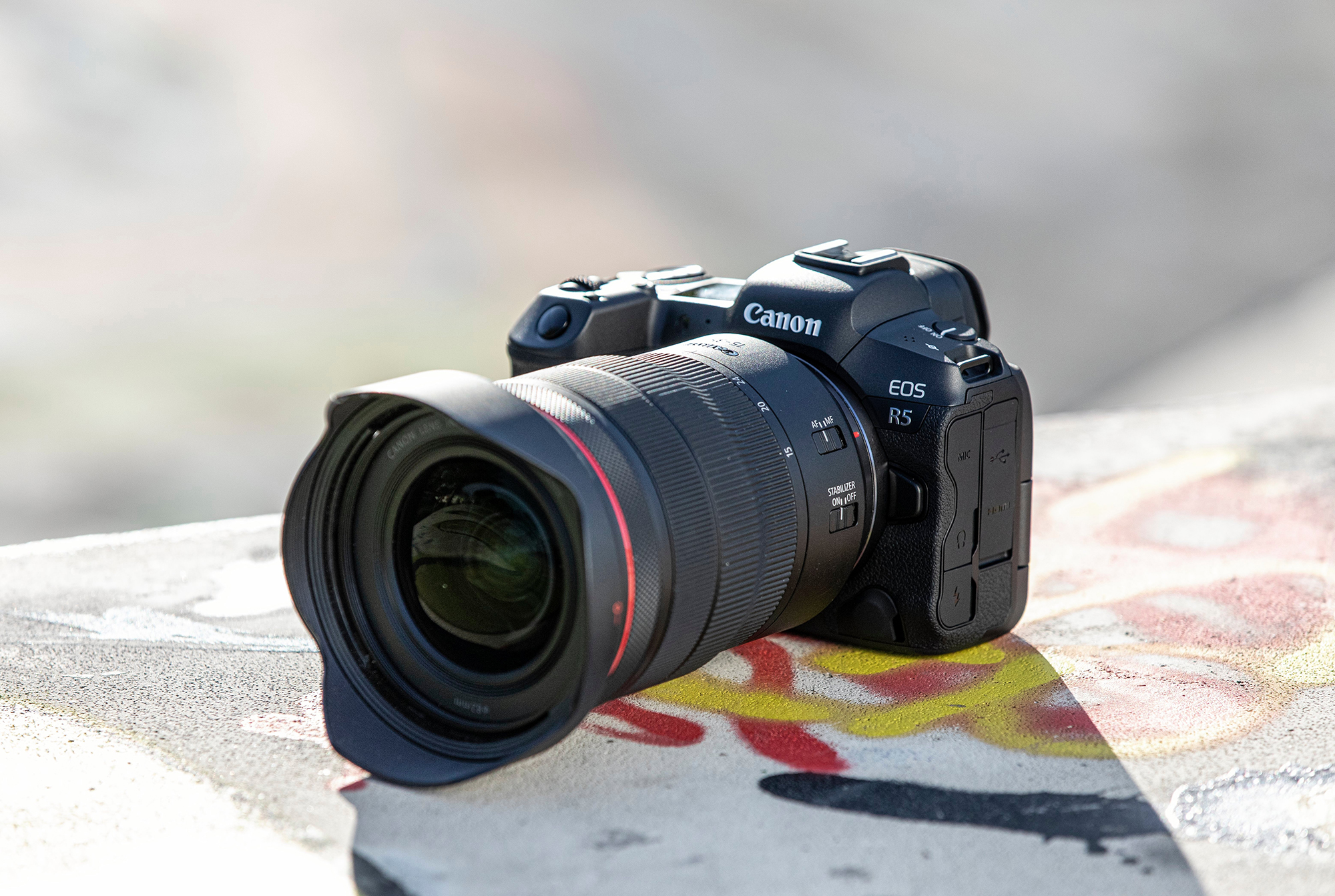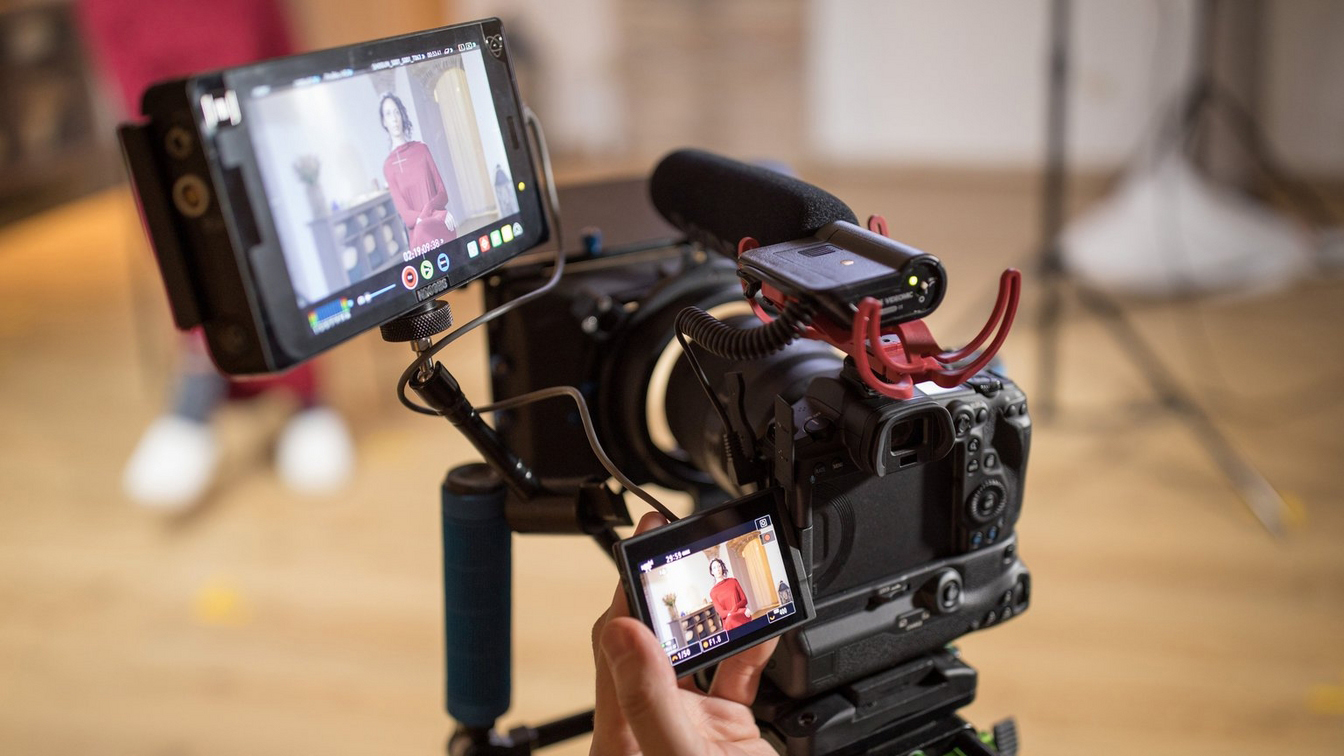Nikon Z8 vs Canon EOS R5 vs Sony A7R V
We invite three leading manufacturers to duke it out to establish which is the best full frame mirrorless camera available

True successor to the D850 DSLR and companion to the existing Z9, providing a ‘best of’ both the Z9 and Z7 II
Pros
- 45.7MP stills
- 8K / 60p video
- 3.2in vari-angle screen
Cons
- Less battery life than the Z9
- Bigger than rivals
Exemplar mirrorless camera offering 45 megapixel stills while being the first in its series to boast 8K-video capture
Pros
- High stills resolution and 8K video capture
- Solid image stabilization system
- Feature rich and versatile
- Best AF performance at launch
Cons
- Expensive, although less so in present company
- Recording limits for video shooting
- 4K video performance is OK
High-resolution camera – denoted by the ‘R’ in its name – that makes a considerable statement in offering 61 megapixels
Pros
- 61MP full-frame performance
- Solid build and feature set
- Extensive lens range and accessories
Cons
- Very few of us will actually need 61MP images
- Premium price tag
- Battery life falls short
Sony has made great strides towards toppling Canon’s longstanding global camera market dominance in recent years, especially as it introduced its Alpha 7 series mirrorless series much in advance of either Canon or Nikon taking mirrorless seriously. However both Canon and to a slightly lesser extent Nikon have gone hell-for-leather in recent years in trying to catch up, meaning that DSLR releases have gone on the back burner in favor of growing their EOS R and Z series mirrorless line ups respectively.
The newest contender of the three full frame mirrorless camera examples we’re comparing and contrasting here, the Nikon Z8, can best be summed up as a baby Nikon Z9, being lighter and more affordable than its manufacturer’s flagship model.
An alternative to this 45MP Nikon is the Canon EOS R5, which again offers 45MP and was acclaimed by us as ‘Canon’s best ever stills camera’ on launch. For those swayed by big numbers, the alternative to both of these is provided by Sony with its own full frame mirrorless camera offering in the A7R V.
Sony’s big appeal is the 61MP sensor at its heart. While most of us may not actually need 61MP images and find the Canon and Nikon’s 45MP specification plentiful, a (very) high resolution does at least afford the possibility of cropping into and enlarging a small portion of our image without losing too much in the way of visible detail. So while it may be overkill for daily use, pro photographers working in the commercial sector could find it useful.
Here we’re comparing all three of these options to allow you to make an informed comparison and find the best mirrorless camera for you. Three is, after all, the magic number…

Nikon Z8 vs Canon EOS R5 vs Sony A7R V: Price and availability
- Nikon Z8: $ TBA / £3,999 / AUS$ TBA body only
- Canon EOS R5: $ 3,899 / £4099.99 / AUS$ 5,999 body only
- Sony A7R V: $3,900 / £3,999 / AUS$ 5,900 body only
At the time of writing the Nikon Z8 has a launch date of 25th May, 2023 at a body only price of $ TBA / £3,999 / AUS$ TBA
Nikon also tells us there will be a new, optional vertical grip available for the Nikon Z8 that takes two EN-EL15 batteries, though pricing and availability for this useful extra is still being confirmed.
Sign up for breaking news, reviews, opinion, top tech deals, and more.
The longest in the tooth of our threesome in being available since 2020, the similarly 45MP full frame sensor incorporating Canon EOS R5 comes with a suggested body only price at the time of writing of $ 3,899 / £4099.99 / AUS$ 5,999.
Available since the end of 2022, the bigger resolution Sony A7R V comes in at a similar body only price of $3,900 / £3,999 / AUS$ 5,900, making it a close call on pricing along – unless, of course, the Sony’s massive resolution wins your favour from the get go.
Bear in mind that, in a competitive marketplace street prices will likely be more affordable than the manufacturer’s quoted prices. So as ever it pays to shop around to grab the best deal; the broad rule of thumb being the older the camera, the more flexibility on price there is.

Nikon Z8 vs Canon EOS R5 vs Sony A7R V: Sensors
- Nikon Z8: 45MP 'stacked' full-frame sensor
- Canon EOS R5: 45MP full-frame sensor
- Sony A7R V: 61MP full-frame sensor
A major bonus with the newest Nikon Z8 is that it features the same 45MP stacked CMOS sensor as the Z series topping Nikon Z9, in a smaller body and at a less expensive price. This will further the Nikon Z series’ appeal for wedding, events, wildlife and landscape photographers looking for a large sensor in a slightly more manageable body. Portrait and astronomical photographers are also suggested markets. We’re promised a faster sensor scan rate with the Z8 too.
The Canon R mount EOS R5 meanwhile also incorporates a full frame CMOS sensor matching its competitor in delivering a maximum effective 45MP. We were told at the time that Canon had deployed a brand new sensor for this model, its performance supported by the R5 being Canon’s first body to feature in-camera image stabilization.
Many competitors’ sensors are of course made by Sony whose ‘7R’ series mirrorless camera line-up is known for its bias towards a high resolution; the E-mount Sony Alpha 7R V is no exception and pushes the pixel boat out in offering a whopping 61MP resolution from its back-illuminated full frame Exmor R CMOS sensor. Whether we actually need all those pixels, given that they’ll deliver a photo realistic printed on huge scales, however, depends on personal requirements. Getting the most out of said sensor is also going to involve opting for Sony’s premium G series lenses at considerable expense.
On a positive note at least we’ll still be able to achieve high quality results from this Sony even if we choose to crop an image tightly and lose most of the original frame. That said, 45MP still images from the Canon and Nikon also offer a lot of opportunity for cropping and re-framing after the fact and that amount of resolution to play with is hardly to be sniffed at.

Nikon Z8 vs Canon EOS R5 vs Sony A7R V: Video
- Nikon Z8: 8K / 60p and 4K / 120p
- Canon EOS R5: 8K / 30p and 4K / 120p
- Sony A7R V: 8K 25p / 4K 60p
In terms of video, the Nikon Z8 offers 8K-resolution capture at 60fps, or 4K-resolution video at up to 120fps for slow motion replay. Videographers – events, weddings, documentary makers and run-and-gun indie filmmakers – will rejoice that the Z8 can record 4K-resolution 60P video for over two hours continuously without overheating, or 8K 30P video for a tight, film-length 90 minutes.
We’re further offered 12-bit ProRes Raw recording, H.265 422 High Efficiency Video Recording and Nikon N-Log footage plus compatibility with third party accessories such as XLR adapters and gimbals.
To be able to handle all of this data, the Nikon Z8 features an Expeed 7 processor as well as dual media card slots compatible with either CFexpress/ XQD cards or more commonly used SD. To ensure the best performance, Nikon recommends using a Delkin black series card.
By contrast the Sony A7R V offers its users up to 8K-resolution video capture at 25fps or alternatively 4K-resolution video oversampled from 6.2K without binning. We also get dual memory card slots, here provided within its handgrip to be able to handle shedloads of data. As on the Nikon Z8, Sony users are afforded the choice of CFexpress memory cards or more regular SD. Shooting 61MP images means we’re likely to run out of card space much quicker than we’re used to, so having a second slot and card pre-loaded avoids any unwelcome interruption. A related first for the ‘R’ series is the inclusion of a latest generation Sony Bionz XR sensor to crunch through data. It goes without saying that high quality imagery is very much at the forefront of this camera’s appeal, so for pros, whether photographers, videographers or both, the price being asked could well be worth paying.
Deliberately described by its maker upon launch as a ‘hybrid’ camera, the Canon EOS R5 achieved the world first in its class back in 2020 of offering 8K video at 30fps for up to 20 minutes of continuous capture (with known overheating issues on heavier use), along with the option of non-cropped 4K, 60P video, with a Digic X processor similar to that found in the manufacturer’s 1D X Mark III DSLR provided to be able to crunch through all the resulting data.
Though the oldest model of our three, the R5’s video footage is also flexible for color grading, with firmware updates since the original launch having added the Canon Log 3 (or C-Log 3) format to enable its footage to slot into cinematic workflows. A combination of stabilised RF mount lenses and in-camera image stabilisation does, in our opinion, also make it possible to achieve reasonably smooth moving images without the use of a gimbal or tripod. Naturally Nikon is also making the claim that its Z8 is light enough for handheld video use, while it should also balance perfectly on any rig, including gimbals.

Nikon Z8 vs Canon EOS R5 vs Sony A7R V: Build & weight
- Nikon Z8: 910g, 3.69m-dot EVF, 3.2in 4-axis touchscreen
- Canon EOS R5: 738g, 5.76m-dot EVF, 3.2in vari-angle touchscreen
- Sony A7R V: 723g, 9.44m-dot EVF, 3.2in 4-axis touchscreen
Of course, all the features in the world don’t mean a great deal if the camera is too bulky or weighty for our practical purposes and chosen subject matter. The Nikon Z8 weighs 910g, a 30% reduction when compared with its manufacturer’s flagship Z9 at 1340g, while at the same time being slighter bigger than the alternative option of the Nikon Z7 II. If so desired, the Z8 can be bulked up further with the additional of an optional new MB-N12 vertical grip, which also boosts battery life by virtue of being able to house two extra Nikon’s EN-EL15 batteries. As we’d expect for a camera aimed at both enthusiasts and professionals, the Z8’s body is weatherproof and, its claimed, has the same tolerance for cold as Nikon’s flagship D6 DSLR and Z9 mirrorless.
Interestingly in terms of build and performance, the Nikon Z8 doesn’t feature a mechanical shutter, thus reducing the possibility for wear and tear while also enabling silent shooting. Elsewhere we get the same 3.69 million dot electronic viewfinder as the Z9, boasting zero blackout. For those looking to shoot in low light, or just in more challenging conditions, there are further on-camera aids via illuminated buttons and the ability to adjust the viewfinder brightness. Also on the body we have twin USB-C ports, providing a means of charging the camera’s battery in the field via a laptop or portable power pack
Despite its boxy appearance, the fifth generation Sony A7V R is actually slightly lighter than the Nikon Z8 at 723g with battery and memory card inserted. A bit of a curious decision here is the camera’s four axis, multi angle LCD screen, which combines a tilting screen with the side-opening pull-out variety found on camcorders. While this is supposed to give us more compositional options we found it awkward to use and ungainly in appearance. In-camera image stabilisation is, however, a welcome feature, particularly for those photographers who prefer to shoot handheld with an eye pressed up against the viewfinder. The Sony’s EVF boasts a magnificent 9.44 million-dot resolution. To say the results are life-like, in that we forget we’re looking at an electronic screen rather than through an optical viewfinder, is an understatement.
The Canon EOS R5 meanwhile features a weather-proofed magnesium alloy body, plus the same 3.2-inch touch screen as the manufacturer’s own EOS R, along with a whopping 5.76 million dot resolution EVF, the highest spec viewfinder to be featured on a Canon at the time of the EOS R5’s release – and which still holds its own in present company. Other key features of the body include body integral image stabilisation, with its gyro sensor combining with lens IS to provide the equivalent of up to 8 steps. Like its rivals above, we also get dual card slots for CF Express and SD UHS-II, a ‘Mark II’ version of Canon’s Dual Pixel CMOS AF technology – marking its range debut and now with animal AF tracking – plus Wi-Fi and Bluetooth connectivity.
The Canon EOS R5 also weighs a manageable yet still substantial feeling 738g with battery and card inserted, so not massively different to the Sony, while both are lighter than Nikon’s newer Z8, even if that camera in turn is lighter than its maker’s Z9 flagship, so will still provide a flexible alternative for existing Nikon users.

Nikon Z8 vs Canon EOS R5 vs Sony A7R V: Additional features
- Nikon Z8: Up to 120fps
- Canon EOS R5: 20fps (electronic shutter)
- Sony A7R V: 10fps
In terms of power, the fact that the Nikon Z8 is a smaller, lighter version of its Z9 perhaps inevitably means that its EN-EL15 battery performance is not quite as impressive as Nikon’s flagship mirrorless. However, otherwise the Z8 offers its users a virtually identical spec to the Z9, essentially taking off from where the Z9 stands now, following firmware implementations since that camera’s original launch.
Nikon converts are also gifted a couple of features on Z8 that are missing from the Z9, including a new AF tracking mode that recognizes aircraft. We don’t lose anything either as included are all the Z9’s subject tracking capabilities, including the ability to recognise and track people, animals and vehicles in the frame. We further get 1/32000 sec shutter speed and minimal rolling shutter, plus the ability to shoot Raw files at up to 20fps to a maximum 1000 shots before the buffer is full.
As for its own power performance, the Canon EOS R5 incorporates a LP-E6NH battery that affords up to 490 shots per charge if we’re primarily using the LCD screen, or a lesser 320 shots if we’re mainly using the EVF. If we’re considering this model for sports or wildlife, it’s worth knowing that up to 12fps images via mechanical shutter or 20fps via electronic shutter can be shot. Interestingly we also get a Dual Pixel Raw function, allowing for a portrait to be ‘relit’ in playback mode, another debut on this particular model. The Canon’s auto focus system also deserves a special mention with its incredibly accurate eye detection and similarly impressive subject detection and tracking.
The Sony A7R V battery life is good for up to 530 photos per charge if using the LCD monitor, rather than its EVF, which feels more than adequate in present mirrorless camera company, if not amazing when ranged against the 900 or 1,000 images typically captured by a DSLR. As is increasingly the case on recent camera releases, the A7R V features what we’re told is a new AI processing unit. This uses deep learning to provide advanced human subject recognition and a high degree of accuracy. It’s fair to say that accuracy and speed when it comes to auto focus is something that all major camera manufacturers have been developing and improving on heavily in recent years.

Which one should I buy?
Those photographers and videographers who’ve come to the conclusion that the future is mirrorless have a wealth of riches to choose from in the Nikon Z8, Canon EOS R5 and Sony A7R V.
Nikon users who have been eyeing up either the flagship Z9 or the Z7 II, that sit just above and just below the new Z8 respectively, now have a further option in the Nikon Z8 that in many respects offers a ‘best of’ both those slightly older cameras. The Z8’s AF performance is an improvement on what the range-topping Z9 offered on its own initial launch, and essentially packs all of that model’s technology into a smaller more reasonably priced camera body – although some will of course prefer the Z9’s larger build, better battery performance and ability to record video for slightly longer, as it can better dissipate heat. However battery life can be improved if opting to buy the Z8’s new vertical grip.
By contrast the Sony A7R V handles like a smaller format DSLR yet one with a huge full frame sensor and class leading 61MP resolution. Its price is not too bad either when compared with what a medium format camera, which is what we’d have needed at one time to achieve anything like as high a resolution, would cost us. It’s also not off-putting when compared with what’s being charged for the Canon EOS R5 or Nikon Z8 / Z9 at the time of writing – allowing potential owners to put any savings when compared with alternative manufacturers towards a good quality lens that the Sony A7R V both needs and deserves.
While the Canon EOS R65 may be the oldest model here, in being something of a pioneer it still holds its own on launch, even if most photographers and videographers looking for a truly hybrid camera are often swayed by Sony with its longstanding expertise in video alongside stills.
It’s worth stating that whichever of these cameras we choose, we’re not just investing in the one camera but a whole system of compatible lenses and accessories, which may, over time, also require considerable outlay. Thus if we already own a bagful of Canon, Sony or Nikon lenses and sundry flashguns our decision for choosing one camera body over the other may well already be made for us. If we’re investing in a mirrorless system from scratch, however, then a great adventure awaits.

When not wrestling wild bears or leaping tall buildings in a single bound, Gavin Stoker can be found editing British Photographic Industry News, the UK's longest running and only photo trade title. He has over 25 years of camera testing and reviewing under his belt.